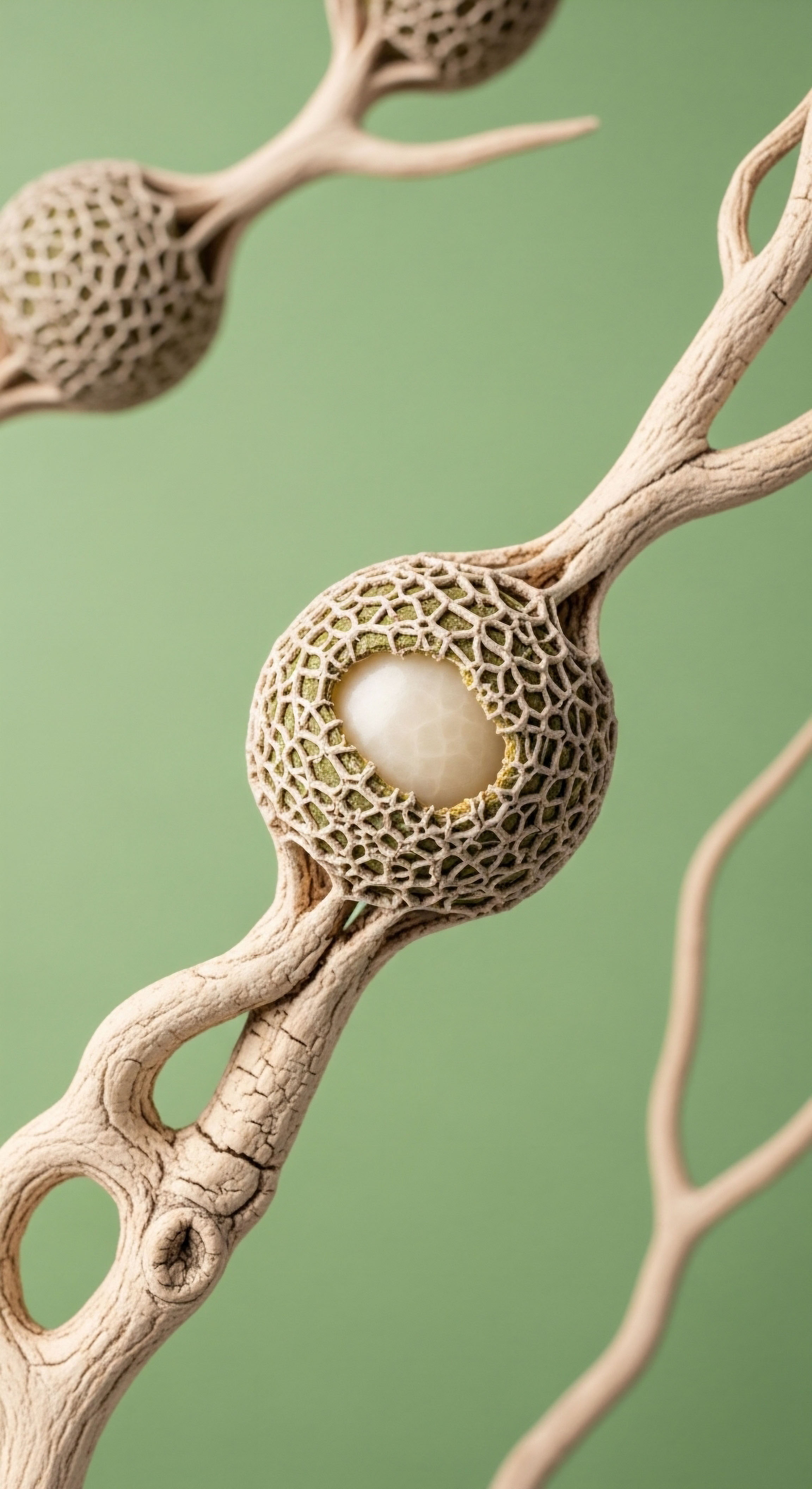

Fundamentals
You may recognize the feeling. A night of drinking that leads to a morning of fatigue, a sense of mental fog, and a pervasive lack of vitality that seems to go deeper than simple tiredness. This experience, common to many, is a direct communication from your body.
It is a signal of a profound biological disturbance that begins with your most sensitive internal messaging network ∞ the endocrine system. The metabolic consequences of alcohol’s hormonal impact are written in these feelings of exhaustion and dysregulation. Understanding this process is the first step toward reclaiming your biological function.
Your body operates on a system of intricate communication, a constant flow of information carried by hormones. These chemical messengers regulate everything from your energy levels and mood to your sleep cycles and reproductive health. When alcohol enters this finely tuned ecosystem, it acts as a powerful disruptor.
It directly interferes with the glands that produce hormones and the tissues that receive their messages. This interference is not a subtle background noise; it is a primary physiological event that commands the body’s full attention, shunting aside other essential metabolic tasks.

The Stress Axis and the Cortisol Connection
One of the most immediate and significant hormonal impacts of alcohol involves the Hypothalamic-Pituitary-Adrenal (HPA) axis. Think of the HPA axis as your body’s central stress response system. When you encounter a stressor, this axis activates, culminating in the release of cortisol from your adrenal glands.
Cortisol is vital in short bursts, preparing your body for a fight-or-flight response by mobilizing energy reserves. Alcohol consumption, however, is interpreted by the body as a significant physiological stressor, triggering a substantial and prolonged release of cortisol.
This elevation in cortisol has immediate metabolic consequences. It signals your body to release stored glucose into the bloodstream for quick energy. While this is happening, your body’s ability to manage blood sugar with insulin can become less efficient. This cortisol surge also helps explain the poor sleep quality associated with drinking.
Alcohol may initially make you feel drowsy, but as your body metabolizes it through the night, the sustained cortisol release can lead to fragmented sleep, early waking, and a feeling of being unrested upon waking. The experience of a “hangover” is in many ways a state of acute, cortisol-driven metabolic stress.
The fatigue and mental fog following alcohol consumption are direct signals of a body managing the profound disruption of its hormonal communication systems.

Impact on Gonadal Hormones and Vitality
Beyond the immediate stress response, alcohol exerts a powerful influence on the Hypothalamic-Pituitary-Gonadal (HPG) axis, the system that governs reproductive function and the production of sex hormones like testosterone and estrogen. This impact is significant for both men and women and is directly tied to feelings of vitality, drive, and overall well-being.
In men, chronic alcohol consumption has been consistently shown to suppress testosterone production. This occurs through multiple mechanisms. Alcohol is directly toxic to the Leydig cells in the testes, which are responsible for producing testosterone. Simultaneously, it disrupts the signaling from the brain (the hypothalamus and pituitary gland) that tells the testes to produce the hormone in the first place. The metabolic results of lowered testosterone include reduced muscle mass, increased body fat, low energy, and diminished libido.
In women, alcohol’s hormonal impact is similarly complex, contributing to irregularities in the menstrual cycle and affecting estrogen and progesterone balance. The liver is central to processing and clearing hormones from the body. When the liver is occupied with metabolizing alcohol, its ability to manage estrogen is impaired.
This can lead to an excess of estrogen relative to progesterone, a state that can influence mood, contribute to menstrual symptoms, and, over the long term, affect bone density and reproductive health. Understanding that a drink is not just a collection of calories but a potent hormonal modulator is fundamental to taking control of your metabolic health.


Intermediate
Moving beyond the foundational understanding of alcohol as a hormonal disruptor, a more detailed clinical picture emerges. The metabolic consequences are a direct result of specific biochemical conflicts and pathway interruptions. Your body’s response to alcohol is a story of resource allocation, where the urgent need to detoxify a foreign substance overrides the precise regulation of your endocrine network. This section explores the specific mechanisms through which alcohol systematically alters hormonal balance and the resulting cascade of metabolic dysfunctions.

Hepatic Metabolism and Hormonal Clearance
The liver is the primary site of alcohol metabolism, and it is also the central processing hub for steroid hormones like estrogen and testosterone. When alcohol is consumed, the liver prioritizes its detoxification above all other functions. This creates a metabolic bottleneck.
The enzymes required to break down alcohol, primarily alcohol dehydrogenase and aldehyde dehydrogenase, are also involved in other critical pathways. The liver’s singular focus on clearing alcohol means that its capacity to perform other jobs, such as metabolizing estrogen, is significantly reduced.
This leads to an accumulation of estrogen in the bloodstream. In both men and women, elevated estrogen levels relative to other sex hormones can trigger a host of metabolic issues. For women, this can manifest as more severe premenstrual symptoms, menstrual cycle irregularities, and an increased risk for estrogen-sensitive conditions.
For men, the consequences are particularly stark. The combination of suppressed testosterone production and impaired estrogen clearance creates a hormonal environment that favors fat storage, particularly visceral fat, and can lead to conditions like gynecomastia (male breast enlargement). This process is further compounded by alcohol’s effect on the enzyme aromatase, which converts testosterone directly into estrogen, an effect that can be potentiated by heavy drinking.
Your liver prioritizes alcohol detoxification, creating a metabolic bottleneck that impairs its ability to clear hormones like estrogen, leading to systemic imbalances.

Acute versus Chronic Hormonal Alterations
The body’s hormonal response to alcohol differs based on the frequency and volume of consumption. Acute intake triggers a different set of responses compared to the adaptations seen with chronic use. Understanding these differences is key to appreciating the progressive nature of alcohol-induced metabolic damage.
| Hormone | Response to Acute Alcohol Exposure | Response to Chronic Alcohol Exposure |
|---|---|---|
| Cortisol |
Significant, rapid increase. The body perceives alcohol as an acute stressor, activating the HPA axis and releasing cortisol to mobilize energy. |
Chronically elevated baseline levels. The HPA axis becomes dysregulated, leading to a state of persistent hypercortisolism, which drives insulin resistance and central adiposity. |
| Testosterone (Men) |
Temporary decrease. Acute alcohol intake can briefly suppress testicular testosterone production. |
Sustained and significant decrease. Chronic toxicity to Leydig cells and disruption of the HPG axis lead to clinical hypogonadism. |
| Estradiol |
Variable, may see a transient increase due to altered liver metabolism. |
Sustained increase. A result of impaired hepatic clearance and increased aromatase activity, contributing to a pro-inflammatory state. |
| Luteinizing Hormone (LH) |
Initial increase as the pituitary tries to stimulate the gonads, followed by suppression. |
Overall decrease or inappropriately normal levels in the face of low testosterone, indicating a failure of the pituitary feedback loop. |

How Does Alcohol Affect Insulin Sensitivity?
The relationship between alcohol, cortisol, and insulin is a critical aspect of its metabolic impact. As established, alcohol consumption drives up cortisol. Chronically high cortisol levels are a primary driver of insulin resistance. Cortisol’s function is to ensure the body has enough energy during stress, and it does this by promoting the breakdown of stored glycogen and protein to raise blood sugar.
It also makes peripheral tissues, like muscle cells, less sensitive to the effects of insulin. This means that more insulin is required to get glucose out of the bloodstream and into the cells.
Over time, this persistent demand on the pancreas to produce more insulin can lead to beta-cell fatigue, while the body’s cells become increasingly resistant. This state of insulin resistance is a gateway to a spectrum of metabolic disorders. It promotes the storage of fat, especially around the abdomen, increases systemic inflammation, and is the precursor to type 2 diabetes.
The seemingly simple act of having a few drinks regularly can set in motion a powerful hormonal cascade that fundamentally alters how your body manages and stores energy.
- Cortisol Surge ∞ Alcohol directly stimulates the adrenal glands to release cortisol, initiating a stress response.
- Blood Sugar Fluctuation ∞ Cortisol mobilizes glucose, causing a spike in blood sugar, which is often followed by a reactive hypoglycemic crash, contributing to cravings for high-carbohydrate foods.
- Insulin Resistance ∞ Sustained high cortisol makes cells less responsive to insulin, forcing the pancreas to work harder and promoting fat storage.
- Visceral Fat Accumulation ∞ The combination of high cortisol and insulin resistance preferentially drives the accumulation of metabolically active visceral fat, which itself is a source of inflammatory signals.


Academic
A granular examination of alcohol’s metabolic consequences reveals a sophisticated sabotage of endocrine function at the molecular and systemic levels. The disruption is not confined to a single hormonal axis but represents a systems-wide failure of regulatory feedback and cellular integrity.
The primary insult of ethanol and its principal metabolite, acetaldehyde, initiates a cascade of events that uncouples the precise, pulsatile communication between the central nervous system and peripheral endocrine glands. This section provides a detailed analysis of the pathophysiology, focusing on the Hypothalamic-Pituitary-Gonadal (HPG) axis as a model for alcohol’s systemic endocrine disruption.

Molecular Mechanisms of HPG Axis Suppression
The suppression of gonadal function by chronic alcohol exposure is a well-documented phenomenon rooted in multi-level toxicity. The primary mechanisms involve direct gonadal toxicity and central suppression of the neuroendocrine cascade.
At the testicular level in males, ethanol and acetaldehyde exert direct cytotoxic effects on Leydig cells. This toxicity impairs the activity of key steroidogenic enzymes, including Cholesterol Side-Chain Cleavage Enzyme (P450scc) and 3β-hydroxysteroid dehydrogenase, which are rate-limiting steps in the conversion of cholesterol to testosterone. The result is a diminished capacity for testosterone synthesis, independent of central stimulation. Furthermore, acetaldehyde can increase oxidative stress within the testes, damaging cellular structures and further compromising steroidogenesis.
Centrally, chronic alcohol use profoundly disrupts the function of the hypothalamic GnRH (Gonadotropin-releasing hormone) pulse generator. The normal, pulsatile release of GnRH is essential for maintaining pituitary sensitivity and the subsequent release of Luteinizing Hormone (LH) and Follicle-Stimulating Hormone (FSH). Alcohol appears to dampen the amplitude and frequency of these GnRH pulses.
This may be mediated by alcohol’s effects on neurotransmitter systems that modulate GnRH neurons, such as GABAergic inhibition and alterations in kisspeptin signaling. The consequence of this dampened central signal is a blunted LH response, resulting in inadequate stimulation of the already-compromised Leydig cells. This creates a state of secondary, or central, hypogonadism layered on top of the primary gonadal failure.
Alcohol’s systemic impact is a story of cellular toxicity and signaling disruption, leading to a profound failure of the body’s essential regulatory feedback loops.

What Is the Role of Sex Hormone-Binding Globulin?
Sex Hormone-Binding Globulin (SHBG) is a protein produced by the liver that binds to sex hormones, particularly testosterone and estradiol, and transports them in the blood in an inactive form. Only the “free,” unbound portion of a hormone is biologically active. Alcohol’s impact on the liver directly influences SHBG production.
While severe alcoholic liver disease often leads to increased SHBG, some meta-analyses of healthy men with chronic alcohol consumption have shown a reduction in SHBG. A reduction in SHBG would theoretically increase the proportion of free testosterone.
However, this effect is insufficient to counteract the profound suppression of total testosterone production, meaning that the absolute amount of free, bioactive testosterone remains significantly lowered. The interplay between total testosterone, SHBG, and free testosterone is a critical diagnostic consideration when evaluating the endocrine status of an individual with a history of alcohol use.

Systemic Interplay with Thyroid and Growth Hormone Axes
The endocrine disruption caused by alcohol extends beyond the HPA and HPG axes, also affecting the Hypothalamic-Pituitary-Thyroid (HPT) axis and the Growth Hormone (GH) / Insulin-like Growth Factor-1 (IGF-1) axis. These systems are critical for regulating basal metabolic rate, protein synthesis, and tissue repair.
Chronic alcohol use can lead to a condition known as euthyroid sick syndrome, where levels of circulating thyroid hormones (T3 and T4) are low, yet Thyroid-Stimulating Hormone (TSH) is not appropriately elevated. This suggests a central suppression of the HPT axis, similar to the effect seen in the HPG axis.
The reduced conversion of T4 (the inactive form) to T3 (the active form) in peripheral tissues, particularly the liver, is also a significant factor. The metabolic consequences of this thyroid suppression include a lowered metabolic rate, fatigue, cold intolerance, and cognitive sluggishness.
The GH/IGF-1 axis is likewise vulnerable. Alcohol can blunt the pulsatile release of GH from the pituitary gland, which is most prominent during deep sleep. Since alcohol disrupts normal sleep architecture, it directly interferes with this crucial period of hormonal release.
Lower GH levels lead to reduced hepatic production of IGF-1, the primary mediator of GH’s anabolic effects. The clinical sequelae include decreased muscle protein synthesis, impaired bone formation, and a reduced capacity for cellular repair, contributing to the overall catabolic state associated with chronic alcohol abuse.
| Endocrine Axis | Central Effect of Chronic Alcohol Use | Peripheral Effect of Chronic Alcohol Use | Primary Metabolic Consequence |
|---|---|---|---|
| HPG Axis (Male) |
Suppression of pulsatile GnRH release, leading to blunted LH and FSH secretion. |
Direct cytotoxicity to testicular Leydig cells, impairing steroidogenesis. |
Hypogonadism, sarcopenia, increased adiposity, insulin resistance. |
| HPA Axis |
Dysregulation of CRH release and impaired feedback sensitivity. |
Adrenal hyperplasia and chronically elevated cortisol secretion. |
Hypercortisolism, hyperglycemia, central obesity, immune suppression. |
| HPT Axis |
Suppression of TRH and TSH secretion. |
Impaired peripheral conversion of T4 to active T3 in the liver. |
Lowered basal metabolic rate, fatigue, cognitive impairment. |
| GH/IGF-1 Axis |
Blunted pulsatile GH release, exacerbated by sleep disruption. |
Reduced hepatic IGF-1 synthesis. |
Impaired protein synthesis, reduced muscle mass, poor tissue repair. |

References
- Rachdaoui, N. & Sarkar, D. K. (2017). Pathophysiology of the Effects of Alcohol Abuse on the Endocrine System. Alcohol research ∞ current reviews, 38(2), 255 ∞ 276.
- Rachdaoui, N. & Sarkar, D. K. (2013). Effects of alcohol on the endocrine system. Endocrinology and metabolism clinics of North America, 42(3), 593 ∞ 615.
- Santi, D. et al. (2023). The chronic alcohol consumption influences the gonadal axis in men ∞ Results from a meta-analysis. Andrology.
- Emanuele, M. A. & Emanuele, N. V. (1998). Alcohol’s effects on male reproduction. Alcohol health and research world, 22(3), 195 ∞ 201.
- Gill, J. (2000). THE EFFECTS OF MODERATE ALCOHOL CONSUMPTION ON FEMALE HORMONE LEVELS AND REPRODUCTIVE FUNCTION. Alcohol and Alcoholism, 35(5), 417-423.

Reflection
The information presented here provides a biological blueprint for experiences you may have felt personally. It connects the subjective feelings of fatigue, mood changes, and diminished vitality to a cascade of specific, measurable hormonal events. This knowledge is a tool. It shifts the conversation from one of judgment to one of physiological understanding.
Your body is not failing; it is responding predictably to a powerful chemical input. What does it mean to view your own patterns through this lens of hormonal cause and effect? How might this clinical understanding inform the personal choices you make to support your body’s intricate, intelligent systems? The path forward begins with seeing your own biology with clarity and respecting the delicate balance required for optimal function.



